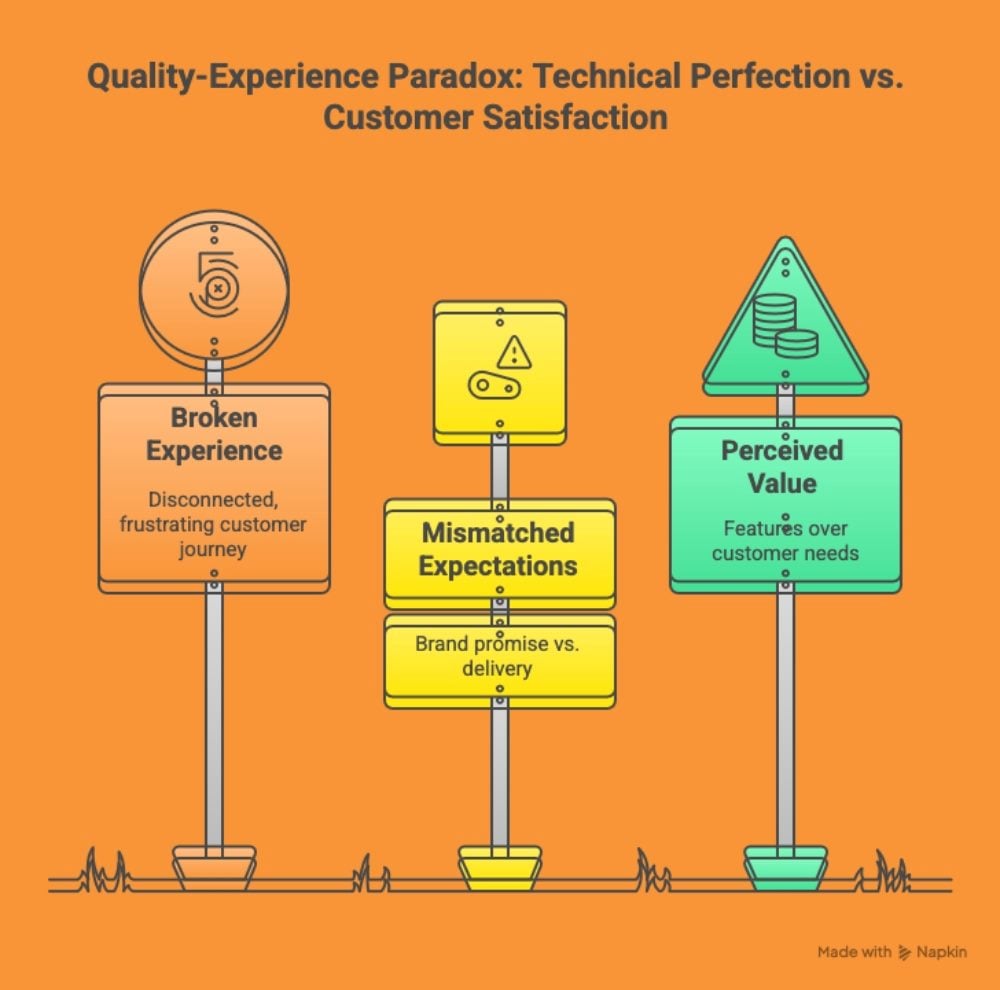The Gist
- Balanced Strategy: A holistic product strategy must balance technical quality with a focus on emotional experiences and user value.
- Empathy in Service: Empathetic and transparent customer service interactions can build trust and loyalty that a product’s technical flaws can’t break.
- Aligned Expectations: A brand’s messaging must accurately reflect the product experience, as a disconnect between marketing promises and product reality can quickly lead to customer frustration.
Lately, I’ve been thinking about what really makes a product feel great for users and, hence, rewarding for developers — and it’s rarely just about dealing with annoyances and mechanical bugs.
There’s this tricky tension I keep running into, something which is often referred to as Quality-Experience Paradox. You can build something technically flawless, and still watch users walk away unimpressed.
Where Loyalty Really Lives
The magic seems to happen when teams push for excellence under the hood and stay deeply tuned into how the product makes people feel. That emotional layer — the journey, the friction, the delight — is where real loyalty lives. I unpack more of this in this op-ed.
Table of Contents
The Emotional Connection Matters: Why Quality Does Not Equal Satisfaction
In tech, we’re constantly told that product quality is everything. Patch the bugs, ship new features, make it faster — that’s the rhythm we all march to. And sure, based on my own considerable experience, these things do matter.
However, after spending years within the industry and observing it from the outside, I’ve begun to notice something I call the Quality-Experience Paradox. It’s a bit counterintuitive: even when a product gets technically better, customers don’t always feel more satisfied. Sometimes, oddly enough, they feel less.
Why? Because “quality” isn’t just about clean code or feature lists — it’s about how the whole experience lands emotionally. Every touchpoint with a brand shapes that feeling. You can have a product that’s polished to perfection. Still, if the journey around it feels disconnected, too technical or blatantly outdated (yes, let’s admit: sometimes we’re too busy to check if the output remains up to the moment), people walk away frustrated.
So the key isn’t about just what works — it’s about what truly resonates.
I’ve seen it time and time again: a product with some technical shortcomings is loved by its users simply because of the positive emotional experience it provides. I mean, it’s real: most people are hungry for nothing more than just a positive emotional experience! This is where customer service can really shine.
Related Article: The Rise of Radical Authenticity: Customers Want Real Over Perfect in 2025
When Service Outweighs Shortcomings
I recall a time when my internet provider — a company notorious for its subpar connection speeds — experienced a major outage. I was bracing myself for a frustrating call, but the support agent was empathetic, transparent about the issue and even followed up personally the next day to ensure my service was restored. The product was technically failing, but the human connection made me feel valued, reinforcing my customer loyalty far more than a hundred feature updates ever could.
The Perfect Product, Broken Experience
Conversely, a product can be a technical marvel but leave you feeling unseen. Think of a cutting-edge fintech app with a beautiful interface and lightning-fast transaction speeds. Yet, when you try to get a simple question answered, you’re met with a confusing chatbot, then an endless phone tree and finally an unhelpful support representative. The product is perfect, but the experience is broken. That frustration, that feeling of being a number, will stick with you long after the technical capabilities are forgotten.
Common Mistakes Leading to Mismatched Expectations
Another critical element of this paradox is the gap between a brand’s promise and its delivery. When a company’s marketing and messaging are out of sync with its actual product experience, customer satisfaction is the first thing to suffer.
Take Salesforce, for example. For years, it has been the industry standard — a symbol of power and comprehensive capability. Let me remind you that Salesforce is a U.S. provider of cloud enterprise solutions for customer interaction. In 2023, the company had surprisingly fired 8,000 employees — reportedly, as part of a one-off cost-cutting effort.
The staff grew during the pandemic: in 2020, the company had 49,000 people, and in 2022, its headcount grew to 74,000. As of 2025, 76,0000 people have been working there. However, the company’s headcount increase, having translated into a broader product count, arguably failed to automatically increase the level of customer satisfaction.
Eventually, the company has accumulated more than 100 million potential customers who could not be called back “just because there were not enough people”. As a result, in 2025, the CEO transferred 4,000 out of 9,000 people from the support service to the sales department and introduced AI agents in both divisions, with whom employees work “in a bundle.”
Learning From Crisis Response
Similarly, I remember the early days of the pandemic and the explosive growth of Zoom. The company was positioned as the lifeline for remote work and education, but its overnight success came with a wave of “Zoom bombing” and privacy concerns.
The company’s response, however, was a masterclass in managing expectations. They didn’t pretend everything was perfect. Instead, they quickly and publicly addressed the issues, revamped their security protocols and over-communicated with users. They took a technically compromised product and, through proactive communication and swift action, built immense trust. That emotional reassurance went a long way toward cementing their position as a market leader, even as they were fixing core product issues.
Related Article: Zoom Lawsuit Brings Video Conferencing Security Into the Spotlight

The Value Conundrum: What Really Works?
The Customer’s Definition Of Value
Finally, we need to talk about perceived value. We in the product world sometimes fall into the trap of believing that more features automatically equal more value. We build intricate new dashboards, add complex analytics or roll out integrations that sound good on a roadmap, but fail to resonate with customers. A simple, elegant solution that solves a core problem is often more valuable than a complex product with a dozen features no one asked for. The customer’s context defines the true value of an enhancement and what matters to them, not by the length of our release notes.
Ultimately, the lesson here is that product quality is just one piece of a much larger customer experience puzzle. Emotional connection, empathetic customer service, clear communication and a deep understanding of what your customer actually values — these are the elements that truly drive satisfaction and loyalty. In the end, it’s not just about building a good product; it’s about building a great relationship.
Related Article: What’s Behind the Best and Worst Customer Service Strategies?
Key Lessons From the Quality-Experience Paradox
This table highlights the core themes explored — balancing strategy, empathy in service and aligning expectations with reality.
| Theme | Key Insight | Why It Matters |
|---|---|---|
| Balanced Strategy | A product must balance technical quality with emotional experiences and user value. | Users judge both functionality and how the product makes them feel, not just one or the other. |
| Empathy in Service | Transparent, empathetic service interactions can outweigh technical shortcomings. | Strong emotional connections build trust and loyalty even when products falter. |
| Aligned Expectations | Marketing promises must match the actual product experience. | A disconnect between messaging and reality quickly leads to frustration and churn. |
Genuine Customer Connections Matter More Than Features
The Quality-Experience Paradox isn’t just some abstract idea; it’s a real challenge for anyone trying to create a product. As a product evolves and becomes more complex, it’s all too easy to get bogged down in the details of features and bug fixes. We are often too focused on metrics like crash rates and uptime, sometimes losing sight of the actual person using the product.
From my own journey, I’ve learned that the companies that truly succeed are the ones that recognize their product isn’t merely a tool; it’s about building a relationship. It’s grounded in trust, empathy and a genuine understanding of what customers really need, rather than just following a roadmap.
So, before you approve that next big feature, take a moment to ask yourself: “Is this really enhancing the product, or is it truly making a difference in the customer’s life?” That’s the question that really counts.
Learn how you can join our contributor community.





